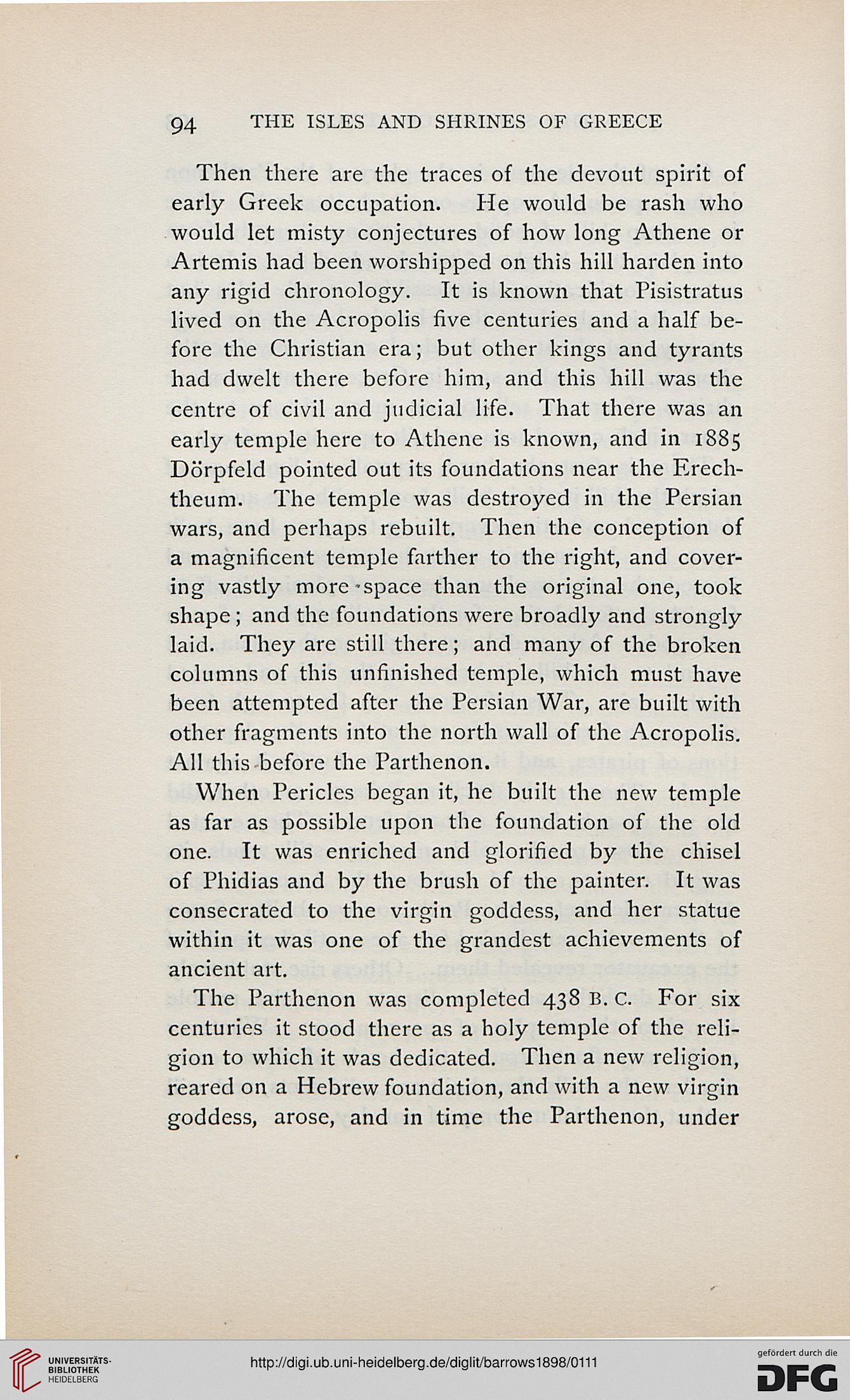94 THE ISLES AND SHRINES OF GREECE
Then there are the traces of the devout spirit of
early Greek occupation. He would be rash who
would let misty conjectures of how long Athene or
Artemis had been worshipped on this hill harden into
any rigid chronology. It is known that Pisistratus
lived on the Acropolis five centuries and a half be-
fore the Christian era; but other kings and tyrants
had dwelt there before him, and this hill was the
centre of civil and judicial life. That there was an
early temple here to Athene is known, and in 1885
Dorpfeld pointed out its foundations near the Ercch-
theum. The temple was destroyed in the Persian
wars, and perhaps rebuilt. Then the conception of
a magnificent temple farther to the right, and cover-
ing vastly more-space than the original one, took
shape ; and the foundations were broadly and strongly
laid. They are still there; and many of the broken
columns of this unfinished temple, which must have
been attempted after the Persian War, are built with
other fragments into the north wall of the Acropolis.
All this before the Parthenon.
When Pericles began it, he built the new temple
as far as possible upon the foundation of the old
one. It was enriched and glorified by the chisel
of Phidias and by the brush of the painter. It was
consecrated to the virgin goddess, and her statue
within it was one of the grandest achievements of
ancient art.
The Parthenon was completed 438 B. C. For six
centuries it stood there as a holy temple of the reli-
gion to which it was dedicated. Then a new religion,
reared on a Hebrew foundation, and with a new virgin
goddess, arose, and in time the Parthenon, under
Then there are the traces of the devout spirit of
early Greek occupation. He would be rash who
would let misty conjectures of how long Athene or
Artemis had been worshipped on this hill harden into
any rigid chronology. It is known that Pisistratus
lived on the Acropolis five centuries and a half be-
fore the Christian era; but other kings and tyrants
had dwelt there before him, and this hill was the
centre of civil and judicial life. That there was an
early temple here to Athene is known, and in 1885
Dorpfeld pointed out its foundations near the Ercch-
theum. The temple was destroyed in the Persian
wars, and perhaps rebuilt. Then the conception of
a magnificent temple farther to the right, and cover-
ing vastly more-space than the original one, took
shape ; and the foundations were broadly and strongly
laid. They are still there; and many of the broken
columns of this unfinished temple, which must have
been attempted after the Persian War, are built with
other fragments into the north wall of the Acropolis.
All this before the Parthenon.
When Pericles began it, he built the new temple
as far as possible upon the foundation of the old
one. It was enriched and glorified by the chisel
of Phidias and by the brush of the painter. It was
consecrated to the virgin goddess, and her statue
within it was one of the grandest achievements of
ancient art.
The Parthenon was completed 438 B. C. For six
centuries it stood there as a holy temple of the reli-
gion to which it was dedicated. Then a new religion,
reared on a Hebrew foundation, and with a new virgin
goddess, arose, and in time the Parthenon, under




